 |
 |
 |
 |
 |
 |
 |
 |
 |
 |
 |
 |
 |
 |
 |
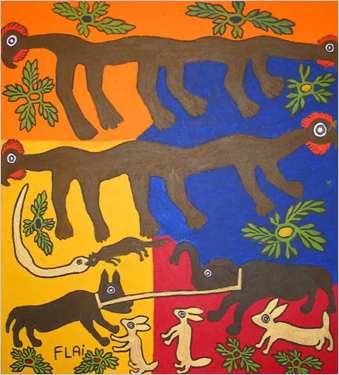 |
|
Flai Shippipa (The Strongest Animal)
!Xun Bushman
1954 – 2009 |
The Legend:
Who is the strongest? Rhino or Elephant? Cunning Hare goes to Elephant and challenges him to a strength test. Elephant humours Hare and says: We can pull against each other”.
Hare then confronts Rhino with the same challenge and gets a similar invitation. Hare subsequently ties a rope around Rhino’s neck and the other side around Elephant’s neck and both start pulling against each other... Both parties surrender eventually, with hare being declared the winner. > |
|
|
|
Flai associates the Bushmen with the hare – they may seem small and weak but have the ability to overcome obstacles. This is one of many traditional Bushmen stories represented in Flai’s colourful and simple work. These stories have revived hundreds of sit-around-the-fire evenings and have been carried over for generations...It reminds him of who he was before the war, and the nomadic existence many of these small families had to endure. Ever present and keeping a watchful eye is the Limboamba or Chicken headed snake - a mythical creature from previous centuries and if myth is to be believed, a presence right from the origins of mankind.
Do not be deceived by the simple lines and innocent manner of illustration. In this artwork there is animation and movement: Hare first running, then sitting up, then tying the rope. There is drama in the background, with snake devouring an animal and the Limboamba playing keeper as the story unravels below him... |
|
|
 |
|
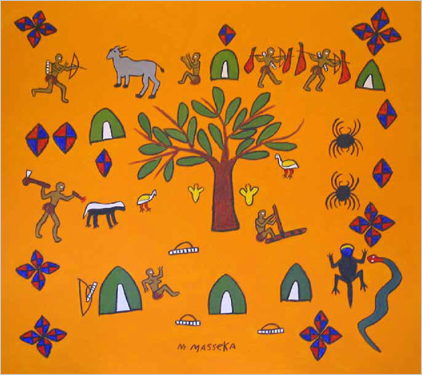 |
|
Manual Masseka (Honey Badger)
!Xun Bushman
1952 - 2010 |
Honey Bird and Honey Bee were once best friends. One day Bee went to Honey Bird and asked for a feather so that it would cure its child of sickness. Honey bird gladly helped. Some time later Honey Birds chick gets sick and can only survive if it gets one of Bee’s wings. Bee refuses, if it gave up its wing it couldn’t fly and its children would die. Honey Birds chick dies, leaving her angry and sad. She decides to make an alliance with Honey Badger, leading him to Bee’s nest and sharing the honey. However Bee gets clever and moves his nest to the top of the trees. Badger and Bird then decides to make an agreement with Man. Honey Badger will follow the Honey Bird with Man following with his axe and fire. The agreement is that man will always take the honey but will leave some for Badger and Bird to enjoy. |
|
|
| |
There is a lot happening inside this striking artwork. One can see man following Badger on his way to the tree where bird is already waiting for her part of the takings as part of the honeybadger legend. True to a hunters story, there is also a hunting scene at the top, with men carrying the meat home in sacks made from intestines and the woman below waiting eagerly for the hunters to return. Also depicted is the Diamphidia and Polyclada beetles (the ‘spiders’ at the right) that - mixed with tree gum - becomes the deadly poison they use at the tip of their arrows. There is a lot of narrative amidst the strong orange African sky and even snake gets his way as it closes in on an unsuspecting lizard baking in the sun. |
|
|
|
|
 |
|
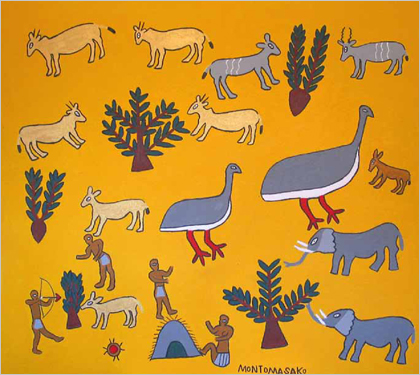 |
|
Monto Masako (Village Life)
!Xun Bushman
About 1930 - 2011 |
This is a truly noticeable artwork reflecting Monto’s trademark observation... Just like Western man would set out various food types before preparing a meal, Monto is revealing how, for them, the whole veld is filled with options, a kind of “what’s on the menu” so to speak. We have elephant, that unknowingly, helps bushmen to gather tubers (swollen underground stems filled with a bitter liquid) by pushing over trees, leaving the roots exposed and easy to access.
He shows us Eland and Kudu, both large animals able to feed a tribe for at least a week and of course the various plants of the veld which, if truth be told, is their staple food from which they can survive long times without meat. |
|
|
|
|
|
 |
|
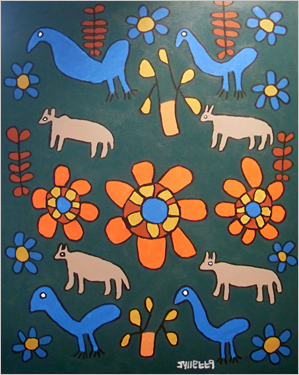 |
|
Julietta Carimbwe (Spring)
!Xun Bushman
1962 - 2008 |
“I do not dream or think about the future because I cannot see it. If I have enough today, it is good.”
Julietta is one of the few Bushmen artists that uses her art, not as a reminder of her heritage, but as therapy for who and what she became. Pablo Picasso said: “Art washes away from the soul the dust of everyday life”. This one can see in Julietta’s colourful, almost decorative images of flowers, animals and plants. For a person who witnessed her family’s tragic and brutal death during the Angolan War, fleeing her home country and loosing her children to illness - she shows reserve and a remarkable determination to see and enjoy all beautiful things. |
|
|
|
|
|
 |
|
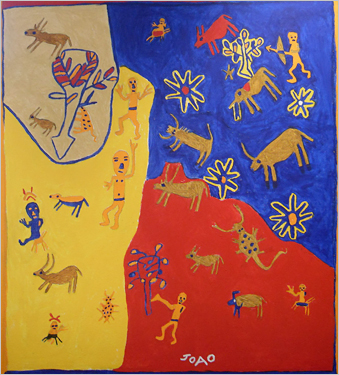 |
|
Joao Wenne Dikuanga (Hunter and Eland)
!Xun Bushman
|
Bushmen acquire an extensive knowledge of animal behaviour through constant observation, careful attention to detail and continual discussion among themselves of what they have seen. Their understanding enables them to identify with the animal they are hunting, so that they can answer questions such as: “What would I do now if I were this animal?” It is hunters like Joao that knew Elands way and how to minimise hardship on this spiritual beast. In this artwork Joao is offering us a glimpse into his mind and the images treasured there. Bucks, Buffalo and Eland grazing peacefully while a team of hunters are encroaching. |
|
|
|
|
|
 |
|
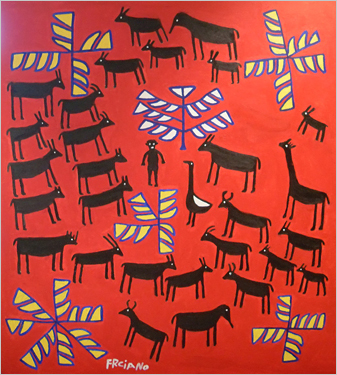 |
|
Freciano Ndala (Veld Animals)
!Xun Bushman
About 1947 -
|
Bushmen are one of the worlds oldest hunting tribes. With a simple bow and arrow they can track for days, patiently wait for their prey and kill efficiently showing a deep respect to the animal. It is in times like those that Freciano waited patiently at the watering hole. He jokingly adds that he can only remember the animals walking to the pan, but never away from it. In most of Freciano’s paintings the animals are facing the same direction, going towards the water pan as seen in this painting. The central figure is Freciano gazing at all the animals he is familiar with. The sun is turning in the sky (yellow mills) and the wind is blowing softly, hiding the scent of Man. |
|
|
|
|
|
 |
|
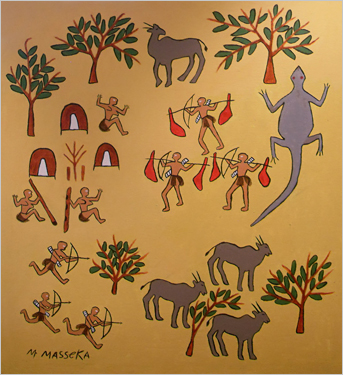 |
|
Manual Masseka (Hunting the Eland)
!Xun Bushman
1952 - 2010
|
The painting tells us a story of the !Xun hunting with the use of “prayer sticks”. These “prayer sticks” were from a tree with red sap. The hunters would gather around the sticks the whole day and night prior to the hunt. Out of respect they would fast and occasionally throw corn kernels to the sticks. They would ask the godsto grant them accesss to the ancestors and offer them guidance for the hunt.
Eland is startled while grazing amongst the trees, a lizard scuttles by. There are a few of them standing around, when !Xun attacks with small bows and arrows, quietly and quickly. They target one buck because it is a big animal and they are against the suffering of any living creature. |
|
|
|
|
|
 |
|
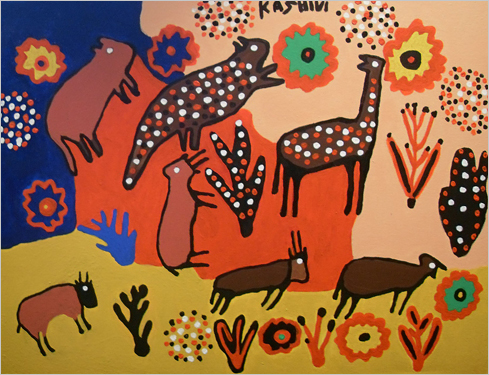 |
|
Andry Kashivi (Seeds)
!Xun Bushman
1958-
|
Kashivi had to, as is custom, go out into the veld regularly as a little girl with her mother to gather seeds, tubers and plants. Here is a classical rendition of the days when seeds “walked with the wind” and simply clung to everything. It’s a subtle yet lively image. The flowers, although decorative is a pre-emptive prophesy on what the seeds will become when the rain falls. |
|
|
|
 |
|
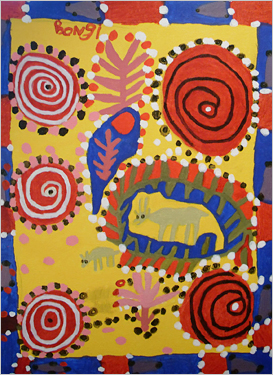 |
|
Bongi Kasiki (Untitled)
!Xun Bushman
|
Like all tribes, the Bushmen have their own belief system and rituals. It is said that when you sing and dance, in repetitive steps while the flames call on the ancestors, you go into a deep trance-like state. You can communicate with your ancestors and see things not visible in the bright African sun. It is in times like these that Bongi sees colourful spirals, animals big and tall and a world sparkling like the sun on a watering hole. Her work in many ways share remarkable similarities with Aboriginal and West African Tribal art.
She believes that when in trance, you can bring the clouds, fill the rivers and ask for !Kaggen to offer a special animal for the next days hunt. |
|
|
|
 |
|
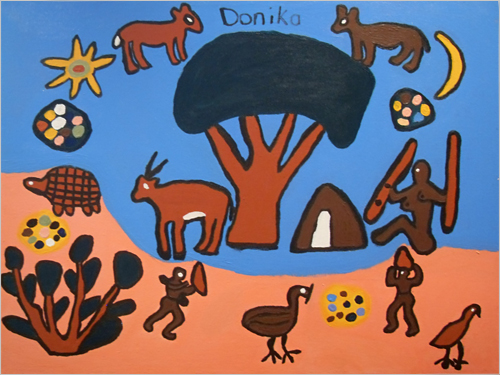 |
|
Donika (Untitled)
!Xun Bushman
|
This is Donika’s first and only painting. She wanted to paint something of her life, something that showed meaning. Although the traditional hunting theme is presented, there are a few fresh ideas jumping off the canvass.
There is a lovely creativity to the animals feeding of the top of the tree, floating on imaginary embers while a buck takes shelter underneath it. As is custom, we are shown the huts with woman making fire and the ever-present hunter setting off on a fresh track while tortoise slowly ambles away. |
|
|
|
 |
|
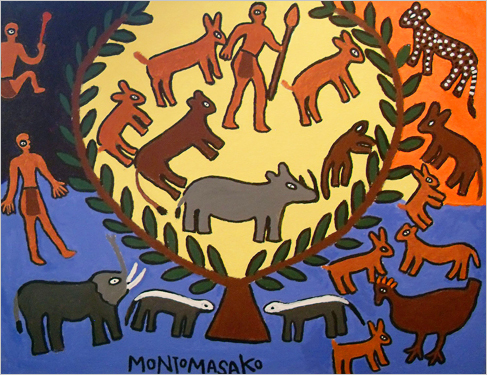 |
|
Monto Masako (The Creation)
!Xun Bushman
About 1930 - 2011
|
According to Bushmen folklore, animals are all men and men are all animal. They are all equal and can talk to each other. Very similar to Indian mythology, the Bushmen believe that man’s spirit travels within an animal to the spirit world. Whenever they kill an animal, they first thank the spirits for the gift of the hunt.
This is beautifully illustrated in Monto’s Painting, animals originating from its paternal leaves with man, already hunter and keeper at the same time. |
|
|
|
 |
|
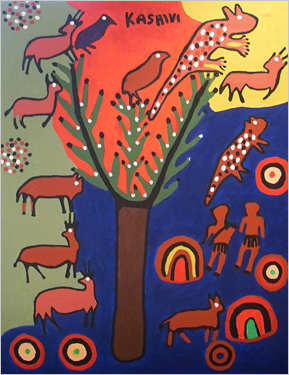 |
|
Andry Kashivi (Startled)
!Xun Bushman
1958-
|
There is a lot of movement and animation in this bright, colourful rendering of a small moment. We have buck getting suspicious at the bottom of the painting only to trot away by the top of canvass. At the same time we have a tree squirrel leaping from the tree and dashing away. One cannot help but wonder who startled whom? Did hunter returning home interrupt a tranquil moment, or did squirrel? Either way, buck chose to move to safer pastures and life continues with birds happily settling back in the tree branches. In true Kashivi style there are colourful dots accentuating movement and strong decorative veld elements to add more charm to this split-second moment of life in the veld. |
|
|
|
 |
|
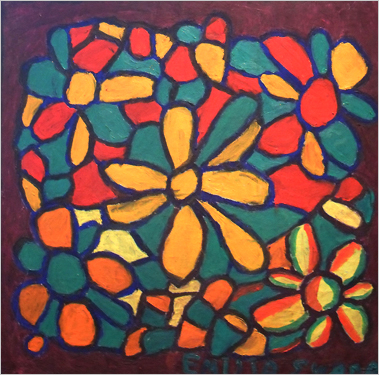 |
|
Emelia Kavangu Muhinda (Flowers)
!Xun Bushman
|
Emelia was traditionally educated by her mom with exceptional knowledge on medicinal plants and bead work. In almost all of her work, there is more decorative elements than story and predominant use of flowers and plants she knew from her days in the veld.
When she was introduced to the art project, she was not challenged on her concept of art but rather left to explore her creative side. This work is one of her first and shows and almost childlike use of colour. What makes her work exceptional is the impasto paint technique, subtle contrasts combined with craft-like design. |
|
|
|
 |
|
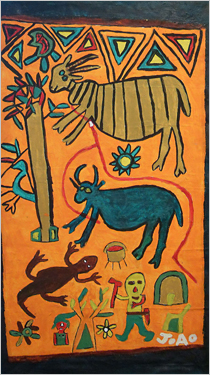 |
|
Joao Wenne Dikuanga (Kudu’s Heart)
!Xun Bushman
|
It is rare for any of these artists to imitate a Kudu, for hunting Kudu is a long and tiresome event. In his carefree naive style Joao is illustrating a very specific form of hunting, called persistence hunting. A big animal like kudu cannot be killed with an arrow, it will only get injured and flee. During the persistence hunt the kudu, is not shot or speared from a distance, but simply run down in the midday heat.
A bushman will chase a kudu for hours to days in scorching temperatures, repeatedly chasing and tracking until it is too exhausted to continue running. The hunter then kills it at close range with a spear. |
|
|
|
|
Here one can see the Kudu resting under the tree, with the red line indicating the route the hunter tracked from his hut to the animals eventual death. Bright oranges and turquoises lends it additional flare with lizard and bush bird joining in on the excitement. It is still early morning and the sun is just painting the sky a bright orange as Jupiter, the morning star is visible in the centre of the artwork. |
|
|
|
|
 |
|
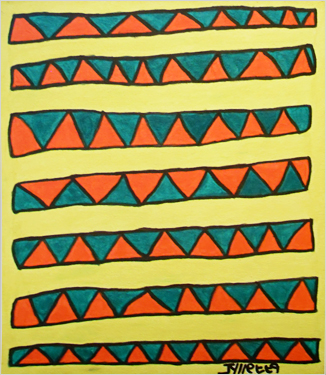 |
|
Julietta Carimbwe (Seasons)
!Xun Bushman
1962 - 2008
|
It is tradition for the men to go out hunting meat, sometimes for days on end. The woman’s task are limited to going into the veld and gathering seeds, plants for medicinal, cosmetic or food purposes and small beetles and birds to cook. Like all societies it is woman’s task to decorate their huts, bodies, children and costumes for celebrations or ritual dances.
The Modern bushmen woman do not only use ostrich egg shells but since the early 60”s also modern plastic beads as found by many African tribes ( the Zulus and Xhosa’s etc.). Here is a classical example of a bead apron as worn by young girls in spring. Its beautiful simplicity and clean line work makes for a striking decoration. |
|
|
|
 |
|
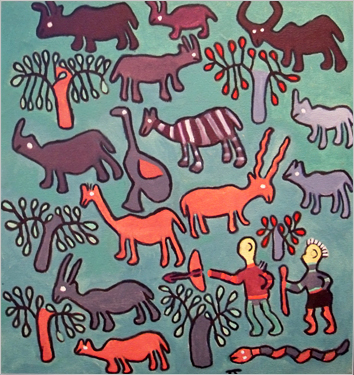 |
|
Katunga Carimbwe (Veld Animals)
!Xun Bushman
|
In true Katunga method, he portrays the animals traditionally seen in the veld and the ever-present baobab tree. Ironically enough, this is the only traditional element in this painting, as the hunters are clothed in Western fashion, placing emphasis on the cultural pull modern Bushmen are experiencing. The traditional loincloth made from softened skin are clearly abandoned for conventional attire. Even more unconventional is the dress like figure at the back, could that be a wife joining in on the hunt? There are some entertaining artistic elements with the hunter dislocated from his bow and arrow in mid hunt due to a background sky intruding - And a new visitor to the sandy plains of Katunga’s world – Male Kudu makes a central but welcome appearance. |
|
|
|
 |
|
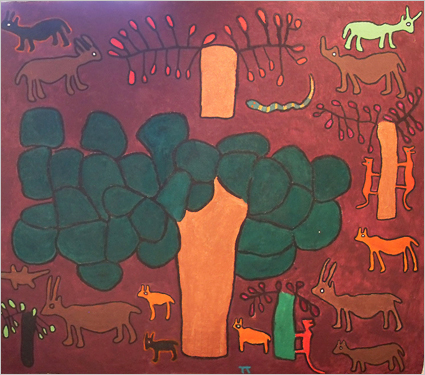 |
|
Katunga Carimbwe (Veld Animals)
!Xun Bushman
|
There is nothing more majestic in the Kalahari than Baobab tree, its higher than any animal and carries a magical presence in an otherwise dry grassy plain. Katunga, like his fellow tribes men, spent many a day out in the blazing heat tracking down prey. If you are thirsty and have been walking for miles, there is nothing better than finding water trapped in the hollows of a baobab tree.
Surprisingly, you won’t find solitude under its high branches: On a scorching day, animals will gather in its shade and wait for the rays of the sun to turn pink and orange before they can retreat to the watering hole for a last drink. |
|
|
|
|
Katunga was fascinated with this phenomena, man and animal taking shelter under baobabs protection. Some animals climbing up the trunk and others simply lazing about, oblivious to the hunter amongst them...And him patiently bidding his time to make the kill. |
|
|
|
 |
|
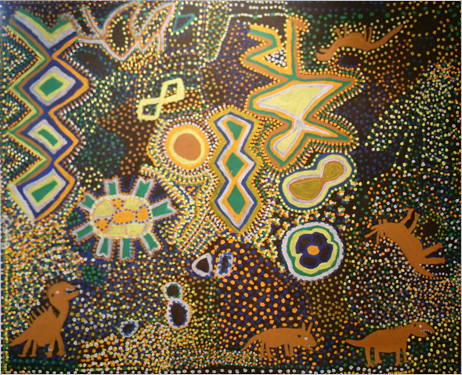 |
|
Bongi Kasiki (Abundance)
!Xun Bushman
|
This is a playful celebration of the veld after the rain. The illuminated painting carries a strong aboriginal presence combined with a mischievous infiltration of Western culture with a few dinosaurs happily frolicking between traditional animals. |
|
|
|
 |
|
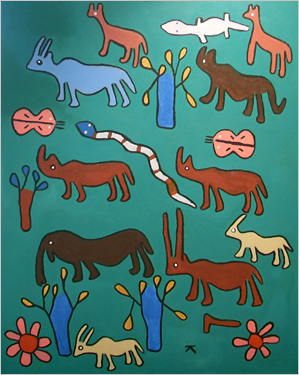 |
|
Katunga Carimbwe (Untitled)
!Xun Bushman
|
It is the Bushmen’s belief that all living creatures, from the smallest moth to the biggest elephant, must be treated with the same respect. When hunting in the veld, they would quite often hunt the older or injured animals first and thereby keep the herd strong in a natural conservationist way. Even snake, who is believed to be the spirit of the ancestors walking amongst men gets treated with respect - rather waiting for its retreat and not killing unnecessarily.
In this painting Katunga is celebrating all animals and the equal space they share in his trademark manner with simple line work and bold use of colour. The animals are all travelling where the water goes , hence them all going in the same direction... |
|
|
|
 |
|
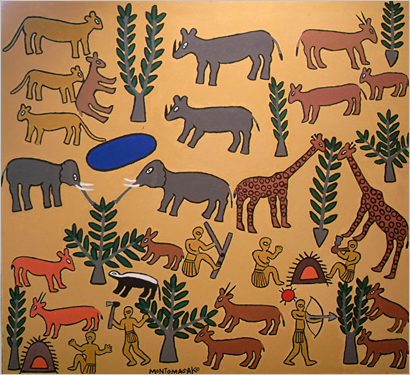 |
|
Monto Masako (Bushman and Animals)
!Xun Bushman
About 1930 - 2011
|
Imagine a world where man and animals live in harmony. Man and animals respect each other and are friends. Then comes another man and separates them into different camps. Man is not allowed to live in the land outside the fence and Animal is free inside his camp only. This is the story of game reserves and how Bushmen like Monto had to flee their ancestral land. This is one of the stories of the Bushmen.
Another story is the Angolan Civil War. The !Xun & Khwe bushmen were used by both the Portuguese Angolan Army and then the South Africa Army for their tracking and hunting skills in a war that had nothing to do with them. After the war they were outcast by society, relocated to South Africa and forced to give up their traditional way of life. |
|
|
|
|
In this painting Monto is remembering the old days, with woman happily working away in the village, men smoking a pipe after the hunt and the animals gathering nearby at a watering hole - when it was just Bushmen and Animals and all was perfect. It’s a postcard of sorts that reminds us of what was lost. |
|
|
|
 |
|
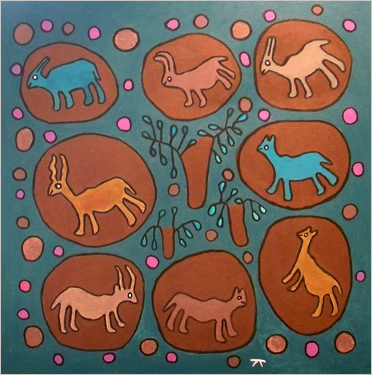 |
|
Katunga Carimbwe (Rock Art)
!Xun Bushman
|
This painting has a touch of innocence with Katunga commenting on ancestral rock paintings. The animals are literally “captured” on each rock and there is no chance of escape. Surrounded by decorative debris and the eternal Baobab tree, this is a simple analogy with great meaning...Modern Bushman longs to stay connected to the “old” ways, there’s great pride in the traditions and abilities of their ancestors. |
|
|
|
 |
|
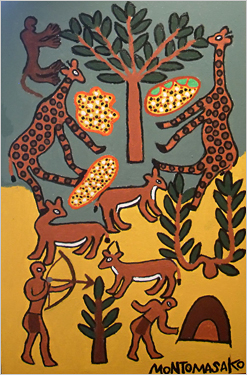 |
|
Monto Masako (Bushman and Animals)
!Xun Bushman
About 1930 - 2011
|
In this painting Monto is depicting an ordinary day in the life of the Kalahari. The Springbok are grazing peacefully, the giraffe are eating from the tree tops and one lonesome baboon is playing the fool.
One can never fully appreciate the observational power of the Bushmen, and what artists like Monto must have seen in their lifetimes. This is a classical postcard of a short, but truly sweet event - bound to be told with great gusto at the fire gathering that night |
|
|
|
 |
|
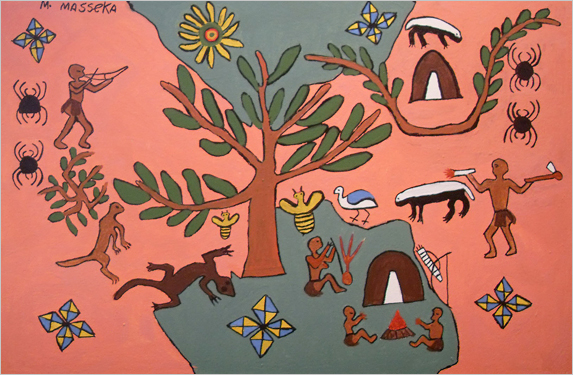 |
|
Manual Masseka (Honey Badger)
!Xun Bushman
1952 - 2010 |
Honey Bird and Honey Bee were once best friends. One day Bee went to Honey Bird and asked for a feather so that it would cure its child of sickness. Honey bird gladly helped. Some time later Honey Birds chick gets sick and can only survive if it gets one of Bee’s wings. Bee refuses, if it gave up its wing it couldn’t fly and its children would die. Honey Birds chick dies, leaving her angry and sad. She decides to make an alliance with Honey Badger, leading him to Bee’s nest and sharing the honey. However Bee gets clever and moves his nest to the top of the trees. Badger and Bird then decides to make an agreement with Man. Honey Badger will follow the Honey Bird with Man following with his axe and fire. The agreement is that man will always take the honey but will leave some for Badger and Bird to enjoy. |
|
|
|
In typical Masseka style, we witness the Honey Badger folklore come to life, combined with an old traditional hunting story of the importance of family. There is also an image of a Bushman making music. This rare image is a treasure, showing the way they held their musical bows between the teeth making clicking noises while plucking or stroking the taught strings in rhythm. A classical image of Meerkat coming up to listen only adds to the charm of this painting. |
|
|
|
 |
|
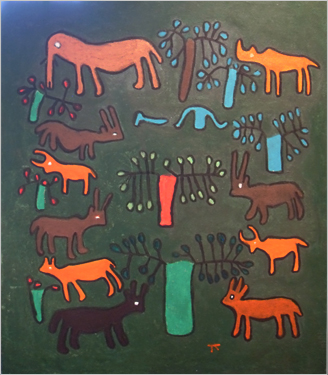 |
|
Katunga Carimbwe (Old Times)
!Xun Bushman
|
For Katunga this is more than just a painting depicting animals and trees, this is a story of survival. Kutunga explains that all animals have a way of surviving, elephant with is size and tusks, rhino with its horns, gazelle with its speed. Man survives because he has hands and can use tools. Only due to this is man ahead of the animals. |
|
|
|
 |
|
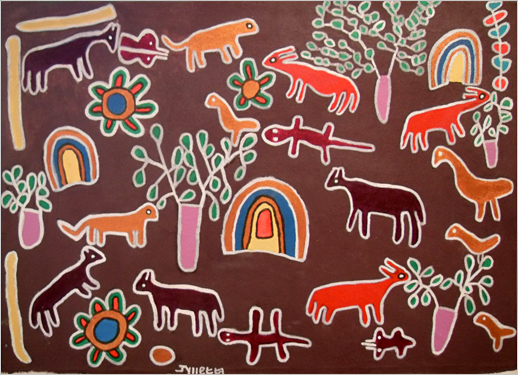 |
|
Julietta Carimbwe (Wild Life)
!Xun Bushman
1962 - 2008 |
Julietta paints because it makes her happy. Her paintings show the beauty of nature and how man fits in. She uses bold lines and a great use of colours. |
|
|
|
 |
|
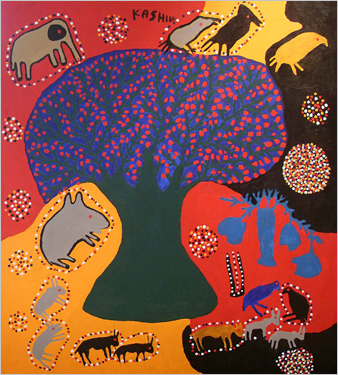 |
|
Andry Kashivi (Baobab Tree)
!Xun Bushman
1958-
|
For Bushmen, trees are central to all life in the veld. It is a gathering place, a shelter from the sun and a hiding place from lion. It bears fruit and seeds that one can use in medicine, beading work and decorations. Their branches makes tools, bows and arrows, furniture and fire. In this painting Kashivi very cleverly illustrates all the animals visiting the majestic baobab tree. It’s spring and the tree is in full bloom. |
|
|
|
 |
|
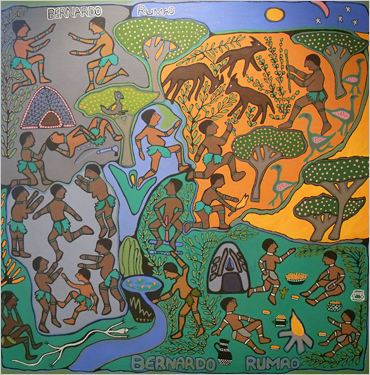 |
|
Thaalu Bernado Rumao (The Old Times)
!Xun Bushman
|
Rumao is like his fellow bushmen, documents the past for future Bushmen generations. There is a treasure chest of information in Rumao’s work though, unlike his peers, his detail is unrivalled and he is truly skilled in figure proportions and spatial layout. There is a daytime scene, the sun rising over baobabs and animal, with huntsman gathering twigs. There are twilight scenes with men lazing around the fire, making fire with sticks and night time talking away and exchanging stories while falling asleep. There is a lot of movement and dialogue in this painting and it invites you to explore every corner and experience something new. Bernado’s trademark double signature is not a sign of an emboldened ego, but a manifestation of being proudly bushmen in a forgotten time. |
|
|
|
 |
|
 |
|
Kunyanda Shikamo (Tree of Life)
Khwe Bushman
1965 –
|
Kunyanda is a Khwe Bushmen from Angola. Traditionally, they lived close to the rivers and practiced fishing and subsistence farming. Like the other bushmen communities they learned the stories of previous generations from their parents and grandparents. These stories were an important part of their education.
This is the story of how the tree is the source of life. Under the tree the insects gather to feed on the fallen fruit, small reptiles, birds and animals gather to feed on the insects. Larger animals come to feed on the reptiles and mammals. Eventually the bigger carnivores gather to feed on them. Many animals feed on the leaves and fruits, some others take shelter. Man however makes the biggest use of the tree. |
|
|
|
 |
|
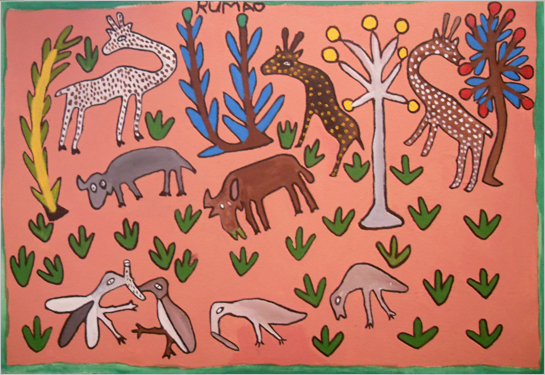 |
|
Donna Rumao (Enough for All)
!Xun Bushman
1960 -
|
This is a bright and light-hearted painting of an everyday moment in the veld. Its spring and most of the trees have delicious fruit and flowers hanging from them, giraffe is bending back in accurate proportional detail to take the fruit of his choice while buffalo is lazily grazing away at the green tufts sprouting up after the rain.
Most beautiful is two Kalahari birds disputing about a worm when their peers are peacefully pulling worms behind them. As is custom in Donna’s work there is always a subtle comment made in a playful manner, in this case about fighting about one worm in a land of plenty. |
|
|
|
 |
|
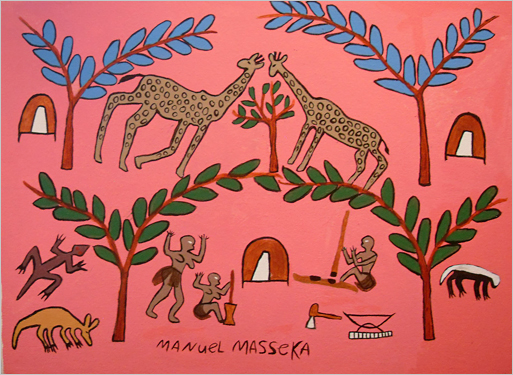 |
|
Manual Masseka (Two Giraffes and Village)
!Xun Bushman
1952 – 2010
|
Manual likes to remember his “previous” life. He is surrounded by the beauty of nature; life in the village is simple. His heart is at peace. |
|
|
|
 |
|
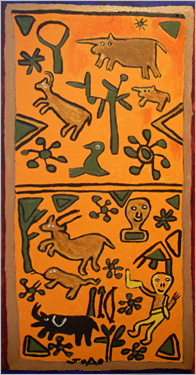 |
|
Joao Wenne Dikuanga (Eland and Animals)
!Xun Bushman
1918-
|
There is a lot of activity in the amber sun of the Kalahari. We have mother and baby Rhino crossing the plain with buck. In the lower section we have a beautiful moment when an Aardvark snatches its prey with its long tongue.
Joao was a great hunter and remembers hunting and all the animals. He recalls hunting the rhino and tells how they used every piece of the animal. The thick skin was dried and made into furniture. It was also ground into a powder and stored in ostrich eggs in the ground, in times of hunger they would dig it up and mix it with water and eat. |
|
|
|
 |
|
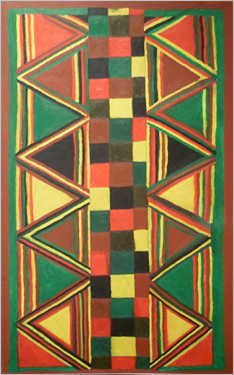 |
|
Flai Shipipa (Untitled)
!Xun Bushman
1954 – 2009
|
This is an early work of Flai and very little is known of this piece. Great care was made in creating these geometric patterns. Unfortunately we will never know its meaning. |
|
|
|
 |
|
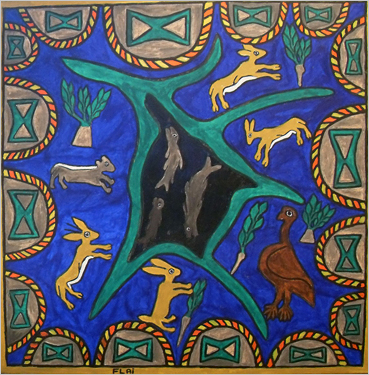 |
|
Flai Shipipa (After the Rain)
!Xun Bushman
1954 – 2009
|
For Bushmen the rain season brings about many wonderful things. They can catch the catfish after they miraculously emerge from the dried up river bed. There’s also plenty of springbok to hunt. This painting also tells an extensive bushmen story. |
|
|
|
 |
|
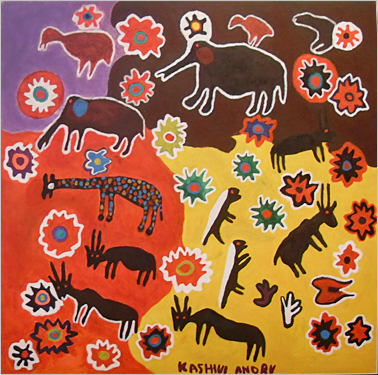 |
|
Andry Kashivi (Abundance)
!Xun Bushman
|
They say there is nothing that compares with the spring flowers in the Kalahari Desert. This painting is simple celebration of all things beautiful at such a time. Everything is wrapped up in spring colours with even Giraffe getting some colourful treatment. The spontaneous exploration of background forms elevates the floral shapes in true trademark Kashivi style. |
|
|
|
 |
|
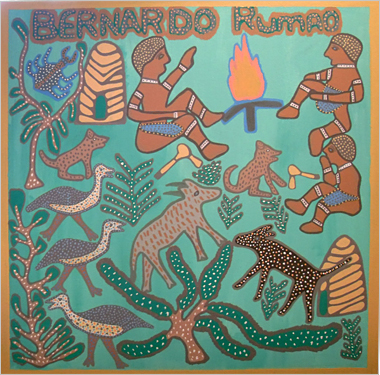 |
|
Thaalu Bernado Rumao (The Old Times)
!Xun Bushman
|
“A lot of our culture is lost in our lives—the old stories that were told by mothers and fathers who would go into the bush and then return to tell the others what they had seen. The problem now is that no one goes out and does anything, so we have no stories to tell our children...We only have the stories of our mothers and fathers...”
These words by Mahongo, the leader of the !Xûn Traditional Council summarises the importance of painters like Rumao’s work. Bernardo imitates a man who is teaching his children how to survive in the wild, choose a place to live, find water and animals and which trees have honey. Exquisite brush work and an innocent sophistication makes this a Bushmen master piece. |
|
|
|
 |
|
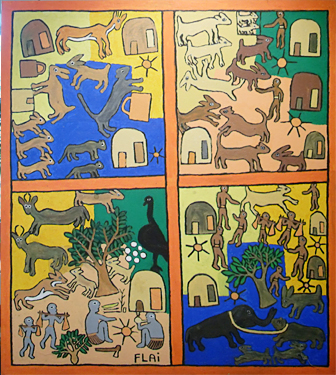 |
|
Flai Shipipa (Bushmen tales)
!Xun Bushman
1954 – 2009
|
This is a beautiful window on Bushmen life from many years ago - several windows to be exact. These are four different bushmen stories which Flai likes to tell. Each story is from the beginning were man and animals can talk to each other.
The stories always have a meaning which is not always apparent at first. The stories often reflect how the small animals (people) outsmart the larger ones. The stories were acted out around a camp fire in the clear Kalahari night. |
|
|
|
 |
|
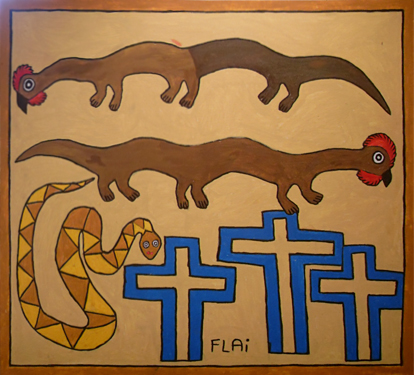 |
|
Flai Shipipa (!Kanga and Cross)
!Xun Bushman
1954 – 2009
|
Every nation in Africa had an identity and belief system before being introduced to other religions. This painting is provocative and meant to be. Flai is not taunting us, but asking us a question, which road to choose...As this is ultimately a cross road. For thousands of years Bushmen have been carrying ancestral beliefs in their hearts and then Western man comes along with a very different belief. They were told that the old beliefs were wrong but in their hearts they still believe whilst accepting the new religion. |
|
|
|
 |
|
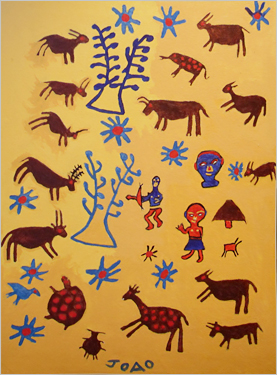 |
|
Joao Wenne Dikuanga (Huntsman)
!Xun Bushman
|
“When I think of the eland inside me, I just take a sheet of paper and draw it”...
Joao’s words betray’s the feelings of almost every artist on the art project. They were all victims of war, hardship and suppression. And bravely enough, they want to remember and treasure the “Eland”, the symbol of Bushmen spirituality despite all its consequences. Joao’s painting is innocent, no sub text or hidden messages: It’s a painting of himself hunting in the veld. Joining him in the veld is a selection of buck, tortoise and trees. |
|
|
|
 |
|
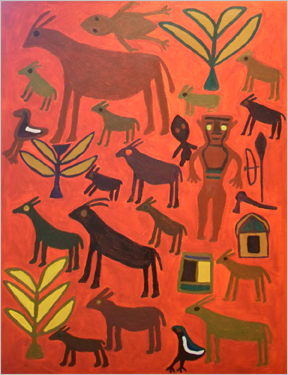 |
|
Freciano Ndala (Veld Animals)
About 1947 -
!Xun Bushman
|
This painting could also be called migration, as all the animals - big and small - are travelling towards another area. One cannot help but wonder if there is drought, judging by the red background it is a hot day in the Kalahari. The only creature staring right at us is the hunter, with his bow and arrows, spear and axe beside him, he is ready for the hunt.
The drought will drive the animals further away. Should he move with them or stay and dance the rain back to his land? The bushmen believe that through dancing they communicate with the spirit world and can change the weather. |
|
|
|
 |
|
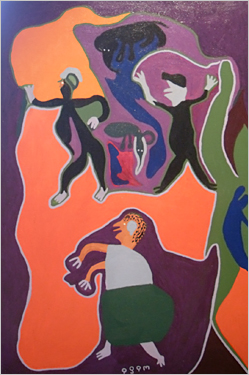 |
|
Ogam (People and Elephant)
Naro Bushman
|
Ogam is Naro Bushman, seperating him from the !Xun Bushmen in mythology and visual style. Its is the dramatic use of movement that most elevates him from his artistic peers.Here is beautiful marriage between past and present. It is the Bushmens belief that one can communicate with the ancestors, heal the sick and bring the clouds through dancing alone. Through rythmic chanting, they reach a trance state allowing them to enter the spirit world. In this painting Ogam is illustrating modern Bushmen, in Western fashion, accessing the spirit world through dance and movement. But all is not lost as the Elephant god morphs from the colourful shapes above and Heron patiently waits for this modern hunter’s request. |
|
|
|
 |
|
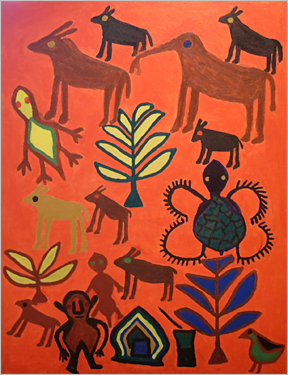 |
|
Freciano Ndala (Veld Animals)
About 1947 -
!Xun Bushman
|
This painting could also be called migration, as all the animals - big and small - are travelling towards another area. The animals are going to the pan, it’s the only source of water around. The turtle symbolizes the pan as it has to live in water. Man has set up home near the pan until the rains return. |
|
|
|
 |
| |
Also shown is the grey go-away bird, which is Bushman’s friend despite its name, they are always close to a herd feeding of their morsels and it is said the animals in the veld shouts at them “go-away, go away” so huntsman cannot find them in the long grass of spring...
It would not be a Monto Masako without a hunting scene, a village hut and woman happily receiving the proud huntsman home. |
|
|
Bushmen are renowned for their silence, only making the occasional clicking sound to indicate an idea or tactic to a team member without raising Elands suspicions. The painting follows Eland through an African yellow day and a night with bright stars glowing on a dark blue sky. Scorpion, badger and wild dog all playing watchmen as the drama unfolds. |
|
|
|
Bushmen are renowned for their silence, only making the occasional clicking sound to indicate an idea or tactic to a team member without raising Elands suspicions. The painting follows Eland through an African yellow day and a night with bright stars glowing on a dark blue sky. Scorpion, badger and wild dog all playing watchmen as the drama unfolds. |
|
|
|
|
Freciano’s simple line work, bright colour use and spatial simplicity has earned him exposure world wide, with the Woolworths group selling almost a million bags with his work printed on them. |
|
|
|
|
|
The wives will have the fires ready and celebrate with Clicking sounds amidst their singing when the men proudly arrive back at the village. They will feast and tell stories under starlight, reflecting on the days adventures and mishaps...
For Masseka the traditional ways of the !Xun is threatened by a younger generation allured by Western culture. Through his painting he wishes them to see and live themselves in the ways of the Old Bushmen and proudly claim back their heritage. |
|
|
 |
 |
 |
Bushmen Art Exhibition, Cape Town, South Africa
Phone: +27 (0)83 557 7481 |











































